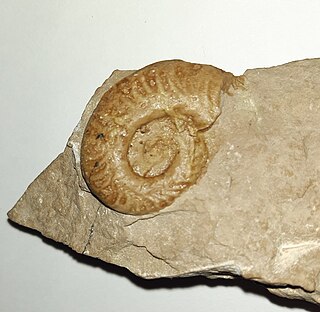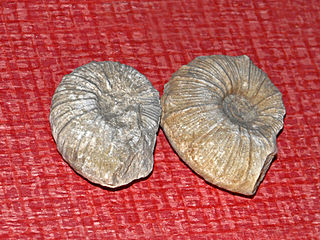Asthenoceras is a genus of ammonoid from the Middle Jurassic with dwarfish, evolute, smooth, compressed, discoidal, strongly keeled shell. Asthenoceras belongs to the Sonniniidae and may be a subgenus of the Lower Jurassic Grammoceras.
Barremites is an ammonoid cephalopod belonging to the family Desmoceratidae, that lived during the Hauterivian and Barremian stages of the Early Cretaceous. Its shell is moderately to very involute, with the outer whorl strongly embracing the inner whorls, and variably compressed. Sides are generally smooth and marked with sinuous or falcate collars marking intervals of growth and bearing feeble striae to moderately distinguished ribs.

Hildoceras is a genus of ammonite from the Jurassic period in the family Hildoceratidae. The shells are characterized by a narrow discoidal evolute shape, keeled venter, concave ribs along the outer flanks, and a shallow spiral groove running along smooth inner flanks. Whorls slightly overlap, cross sections are compressed. The ventral keel is bordered on either side by a shallow groove. The genus was named by Alpheus Hyatt after Saint Hilda in 1876.

Lytoceratidae is a taxonomic family of ammonoid cephalopods belonging to the suborder Lytoceratina, characterized by very evolute shells that generally enlarge rapidly, having whorls in contact but mostly overlapping very sightly, or not at all.
Alocolytoceratinae is a subfamily of lytoceratids that comprises genera characterized by many deep constrictions in the shell resulting in capricorn-like ornamention, especially in the middle whorls, but becoming smooth and more involute in the outer whorls. Saddle endings in the suture tend to be phylloid, (leaf-like).

Lytoceratinae is a subfamily of ammonoid cephalopods that make up part of the family Lytoceratidae.
Ptycholytoceras is a genus of fast-moving nektonic ammonoid carnivores included in the Lytoceratinae in which the shell has round inner and depressed outer whorls and sides with dorso-ventrally sloping folds that do not pass onto the venter.

Harpoceras is an extinct genus of cephalopod belonging to the family Hildoceratidae. These cephalopods existed in the Jurassic period, during Toarcian age from Falciferum zone to Commune subzone of Bifrons zone. They were fast-moving nektonic carnivores.

Holcodiscus is an ammonite genus placed in the family Holcodiscidae. Species in this genus were fast-moving nektonic carnivores. The type species of the genus is Ammonites caillaudianus.

Hammatoceras is a genus of ammonites belonging to the family Hammatoceratidae which lived during the Late Toarcian stage of the Early/Lower Jurassic between about 184 and 175 million year ago.

Cleviceras is an extinct genus of cephalopod belonging to the family Hildoceratidae. These cephalopods existed in the Jurassic period, during Toarcian and possibly even uppermost Pliensbachian age. Sometimes, it is considered to be a synonym of Eleganticeras.
Peronoceras is genus of ammonite that lived during the middle Toarcian stage of early Jurassic. Members of this genus existed only in Fibulatum Subzone of Bifrons Zone. Their fossils were found in Europe, northern Africa, Asia, North America and South America.
Porpoceras is genus of ammonite that lived during the early and middle Toarcian stage of early Jurassic. Members of this genus existed from uppermost part of the Harpoceras serpentinum zone to the Haugia variabilis zone. Their fossils were found in Europe, Asia, North America and South America.
Septimaniceras is genus of ammonites that has probably evolved from Peronoceras and lived during the middle Toarcian stage of early Jurassic. Members of this genus existed from Bifrons Subzone to lower part of Variabilis Subzone. Their fossils were found in France, Hungary and probably also in Austria.
Catacoeloceras is genus of ammonite that lived during middle to late Toarcian stage of early Jurassic. Members of this genus existed from Crassum Subzone of Bifrons Zone to Variabilis Zone. Their fossils were found in Europe, northern Africa, Asia, North America and South America. It has evolved from Peronoceras, or Porpoceras.
Nodicoeloceras is genus of ammonite that lived during early to middle Toarcian stage of early Jurassic. Members of this genus existed from Exaratum Subzone of Falciferum Zone to Commune subzone of Bifrons Zone. Their fossils were found in Europe, northern Africa, Asia, North America and South America. It has probably evolved from Dactylioceras (Orthodactylites) or Kedonoceras and gave rise to Mesodactylites.
Mesodactylites, which is sometimes considered to be a synonym of Nodicoeloceras is genus of ammonite that lived during early to middle Toarcian stage of early Jurassic. Their fossils were found in southern and central Europe and northern Africa. It has evolved from Nodicoeloceras.
Transicoeloceras, which is sometimes considered to be a synonym of Catacoeloceras is genus of ammonite that lived during Toarcian stage of early Jurassic. Their fossils were found in Hungary, Italy, France, southern Spain and South America. It has evolved from Mesodactylites.
Telodactylites, which is sometimes considered to be a synonym of Porpoceras is genus of ammonite that lived during Toarcian stage of early Jurassic. Their fossils were found in Europe, northern Africa and South America. It has probably evolved from Mesodactylites.
Mucrodactylites, which is sometimes considered to be a synonym of Collina, is genus of ammonite that lived during middle to late Toarcian stage of early Jurassic. Their fossils were found in Europe, northern Africa and South America. Species belonging to this genus were probably microconchs of Catacoeloceras. As macroconch of M. mucronatus is considered to be Catacoeloceras raquinianum.







